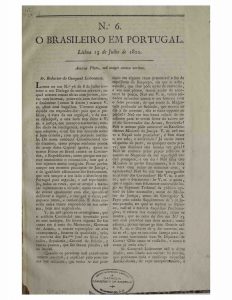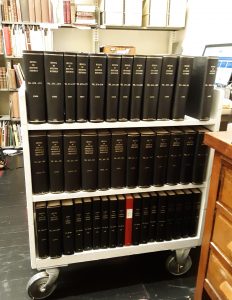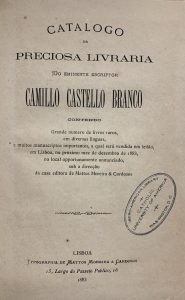By Erin Mir-Aliyev
Master of Science in Library and Information Science – The Catholic University of America
Flora de Oliveira Lima Fellowship for Graduate Students in Library and Information Science – The Oliveira Lima Library
One of the most important figures in the development of the Oliveira Lima Library during the mid to late twentieth century is its former curator, Manoel Cardozo. Though Cardozo was a well-known scholar within the fields of Brazilian, Portuguese, and Latin American studies, not many members of the wider Catholic University community or the general public know who he was or understand the role he played during his time at Catholic University. Recognizing this, and wishing to remember his contributions at the 35th anniversary of his death this December 15th, the highlights of his career have been outlined here to provide readers with an idea of his accomplishments and his legacy.
Cardozo’s Dynamic Academic Career

As an academic, Manoel Cardozo was involved in a wide variety of scholarly activities within the local Catholic University community, and also on a national and international level. Beginning in 1940 he was a lecturer, then from 1954 a full professor, of Brazilian and Portuguese history and literature. He then headed the Catholic University history department for a decade between 1961 and 1971, in addition to various other academic and administrative positions. He was also President of the Catholic Historical Association in 1962, as well as being active throughout the 1940s, 50s, and 60s in organizations such as the Conference on Latin American History of the American Historical Association and the American Association of University Professors, attending international meetings and conferences such as the Congress on the Expansion of Portugal in the World, and serving on the Board of Directors of two major publications, The Americas and the Catholic Historical Review. We are aware that he was a significant mentor to at least one CUA history student, Karl M. Schmitt, whose photographic collection resides in the American Catholic History Research Center and University Archives. Through various archived newspapers, we can tell that he organized exhibitions of Brazilian art or other materials depicting themes or subjects relevant to the library’s collections. Cardozo’s research and lecture activities led him on many occasions to travel across the United States, to Europe, especially Portugal, and to multiple countries in Latin America, including Brazil. His work earned him multiple awards, including the Benemerenti Medal in 1974, a medal awarded by the Pope in recognition of service to the Catholic Church.

Image source: “Manoel De Silveira Cardozo I.A.17-1.” The American Catholic History Research Center and University Archives, The Catholic University of America.
Curatorship of the Oliveira Lima Library
After the death of Manoel de Oliveira Lima’s wife and assistant librarian, Flora, in 1940, Cardozo took over the curatorship of the Oliveira Lima Library. As the child of Portuguese parents who had immigrated to California, a successful student at Stanford University, and the former mentee of the prominent Latin American scholar Percy Alvin Martin, Cardozo had the personal background, education, experience, and enthusiasm that made him an ideal candidate to care for Manoel de Oliveira Lima’s book collection and archival documents, and to establish it as a permanent part of the Catholic University Library for future generations of students and researchers.
His many tasks at the library included continuing to accession and catalog rare and modern books, organize the archives, and care for the many pieces of valuable artwork contained in the collection. Records and articles also show that he travelled internationally specifically to collect new books for the library.
Writings
Something else Manoel Cardozo left behind that allows us to understand him and still influences researchers today is the writings he produced. While pursuing his academic career and serving as Oliveira Lima Library’s curator, Cardozo was also a prolific writer. His work encompasses a wide variety of topics and types of materials, including political, religious, diplomatic, and intellectual history, and pamphlets, journal articles, newspaper articles, and reviews of others’ works. Many of the materials he produced are available and searchable at the Oliveira Lima Library or in Mullen Library, or are otherwise available through the CUA catalog.
A project by Oliveira Lima Library staff this fall to collect various materials about, by, or associated with Cardozo available through the CUA library has so far resulted in more than 230 items of which he was the main author or otherwise a contributor, over 70 newspaper articles with mention of him, and almost 75 items present within the Oliveira Lima Library with inscriptions by or to him, or stamps or other signs of ownership by him. Most of his writing was done in English, though occasionally he did write in or review works in Portuguese, demonstrating a knowledge of at least two languages. Some examples of his works include The Latest Word on Portuguese Orthography (1944), Oliveira Lima and the Writing of History (1954), and Slavery in Brazil as Described by Americans, 1822–1888 (1961), demonstrating a range of topics such as language, Manoel de Oliveira Lima himself, and slavery in society and history. Newspaper articles revealing his involvement in activities around campus and elsewhere include an article mentioning his role in the Foreign Students’ Association planning for a festival, (1954), another article mentioning him as moderator in a televised discussion among faculty members (1964), and a third article about him leading a summer school-affiliated tour through Latin America (1951). Representing a sample of books showing ownership by Cardozo, the book Antropologia e História (1954) contains an inscription by its author to Cardozo, Indice de Biobibliografia Brasileira (1963) contains a note saying it is a presentation copy by Manoel Cardozo to the library, and Latin America, A Modern History (1958) contains an ownership stamp, and possibly the personal notes of, Manoel Cardozo. These details help reveal or indicate what he found interesting or valuable, how he interacted with other professionals, and his activities as curator.

Image source: The American Catholic History Research Center and University Archives, The Catholic University of America.
While we will likely uncover much more information as our staff works further on this project and works through cataloging the Oliveira Lima collection, the accomplishments mentioned above offer a little insight into who Manoel Cardozo was as an individual, his passion for Latin American history and culture, and his dedication to providing CUA faculty and students, as well as those outside the CUA community, with more resources about these topics.






















